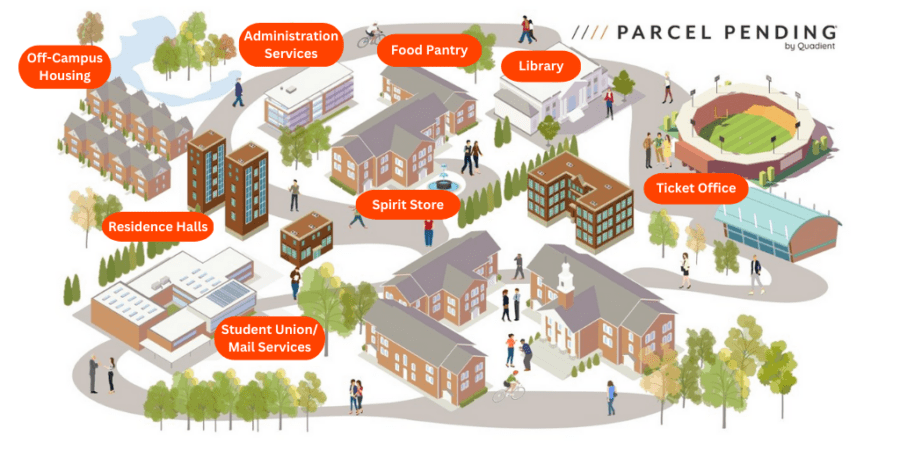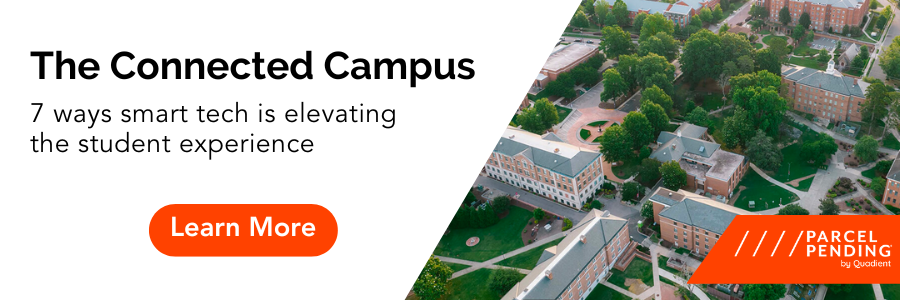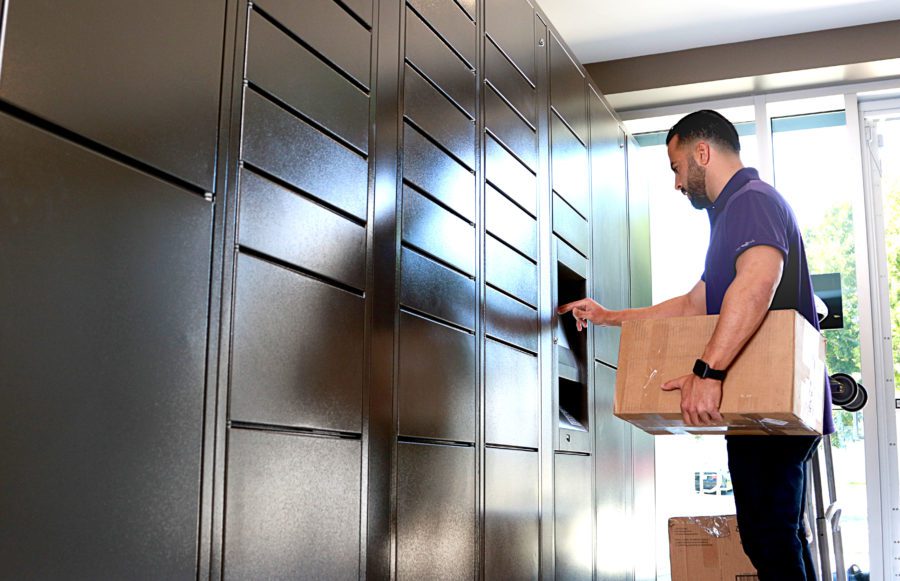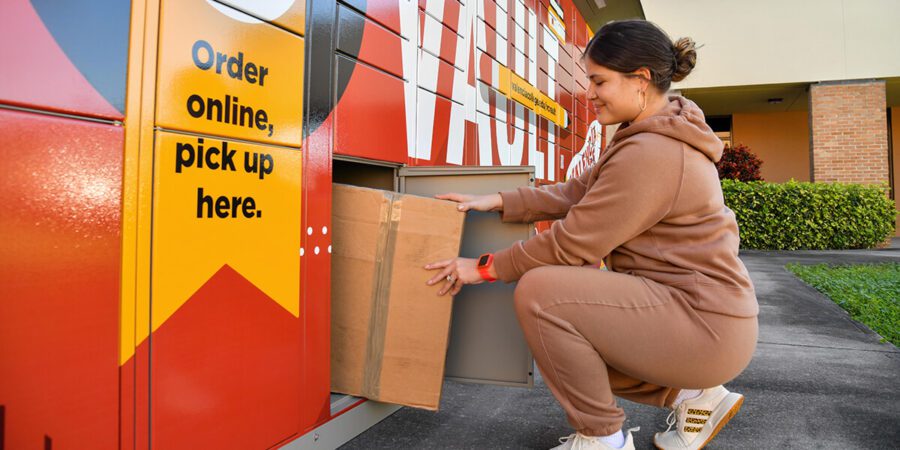
University
Introducing Campus Hub: A New Platform for Distributing Goods on Campus
Written by: Parcel Pending
5 Min Read
Published: April 30, 2021
Updated: August 7, 2023
Just prior to the COVID-19 pandemic, we saw the use of smart lockers on college and university campuses starting to grow. These smart college lockers were being utilized to streamline on-campus mail center services and the overwhelming number of daily packages and deliveries that students and staff were receiving.
However, what is thought of as a “smart locker” today may essentially not provide as much value in the future if higher education institutions don’t innovate how they’re using them beyond simply the mail center.
Like many other products and service areas, COVID-19 has accelerated smart technology innovations to adapt to the times. Looking longer term, it may no longer be enough for a smart locker to simply manage packages and deliveries for the mailroom.
Enter the Campus Hub concept.
The Campus Hub distribution method is a simple concept – lockers as an exchange point for various items and goods. And it is the asset-tracking software in the platform that is needed to ensure the system can keep getting smart. This helps solve two major pain points plaguing the higher education space right now – the ability to do more with less staff, labor and resources and the need to create a revenue-generating module.
These colleges aren’t simply purchasing a product. Rather, they are building a platform for distributing goods and items via a self-service, smart locker system that leverages existing processes and provides a comprehensive chain of custody. In essence, a smart locker solution today really should offer the following in order to remain relevant tomorrow:
- Chain of custody in one system for packages that do not go in a locker. This includes large items, medicine, high-value items, food and more
- Ability to utilize lockers for both pick up and return of goods and assets
- Mail distribution on the same communication platform
- Ability for other departments to “tap “into the system for their own needs while allowing the process to remain the same for students and staff
- Ability for the system to talk to other software already on campus so other departments can easily plug in: including the library, bookstore, IT department, cafeteria/dining hall and more
Below is a quick overview of what the Campus Hub distribution method is all about, and how it is poised to benefit colleges and universities looking to do more with less resources:
Beyond Mail & Packages
First, smart lockers are proven to reduce on-campus mail center labor resources by as much as a third because nearly anything can be delivered safely and securely into a locker. Ikea furniture? Check. Care package from mom? Check. New laptop? Check.
A whopping 80% of all online orders and packages, including groceries, medications, bedding, dorm room decor and more, can be delivered directly to parcel lockers. We all know that operational savings are so important right now, and this is where smart lockers can really make a tangible impact. You must, however, track the other 20% of items that do not go in a locker with the same technology.
The Campus Hub empowers colleges and universities to leverage smart lockers to disseminate much more than just mail and packages, this includes:
- Food Pantry: Convenient and discreet storage solution for both perishable and non-perishable food items, allowing students to pick them up at their convenience.
- Library Materials: Books, articles, periodicals and other materials students may need from their on-campus library. All information is tracked and saved providing a full chain of custody.
- Bookstore Merchandise: Clothing, books, electronics, gifts and more can be retrieved with zero face-to-face interaction.
- Electronics: Student laptops, tablets, and other school-owned devices can be disseminated.
- Class Equipment: Classrooms can distribute equipment for coursework and projects and students can easily and safely return the items.
- On-Campus Dining: A student can simply place an order for a meal online via the university’s dining software and then pick-up their food and beverage items safely without coming in contact with anyone.
- Student Mail: Packages and regular USPS mail.
- Move-in/Move-out Materials: Items such as keys, ID cards, welcome packets and other important school materials can be shared with students via smart lockers.
- Event Tickets: Tickets for sporting events and other student activities can be distributed via smart lockers to minimize lines and contact with ticket agents.
Having the ability to drop off laptops, library materials and outgoing packages with a secure timestamp back to each department maintains the chain of custody and reduces the need to install multiple systems.
But picking up goods and assets is not enough. Returns are becoming a major problem as well. These smart lockers in the hub also can be used to return goods and assets.
With the ability to move all sorts of goods and items on-campus quickly, easily and securely, colleges and universities are providing a safe, contactless and premium student experience while also saving valuable staff time and resources.
Chain of Custody
Smart lockers must come with a base software that provides a chain of custody for all goods – not just packages – being distributed on campus. This means that all on-campus departments – be it the mail center, library, bookstore and more – can tap into this single software to access chain of custody for whatever it is they have moving around campus.
We call this “asset tracking software” and it is easily integrated into a college’s or university’s tracking system. It gives them a single, cloud-based system that provides full chain of custody and flexibility around routing for all packages and other assets distributed on campus.
This makes it quick, easy, and most importantly cost-effective for different on-campus departments to distribute and track goods. In fact, funds can be pooled from various departments so that the investment cost for the system is reduced as only one software system is utilized.
The Campus Hub also provides services beyond just on campus students and staff. By offering lockers at outdoor locations the service can be available for commuter students as well as off campus students. The system will allow these services as a new revenue stream for the University.
Managing Mail Distribution
Aside from packages and deliveries, the Campus Hub concept also allows colleges and universities to manage mail distribution with a few options. The most popular and cost-effective is High Density Mail. Instead of sending someone out to drop mail in outdated mail slots at the dorms, which students don’t even check anymore, instead the system can send a text message that mail is ready to be picked up. This is the same system the locker uses but instead the staff simply has a set of folders labeled A-Z and the letter is ready for pick up. There are a few universities that actually take it a step further and scan all mail pieces for students and staff and send a picture asking the recipient to decide whether they want it, discard it, open and show me or send it to another address. This results in tremendous savings on delivery on campus and saves space where the mail slots used to be.
Contactless
By utilizing a campus hub concept, colleges and universities are proactively keeping students, staff and faculty safe by minimizing touchpoints, providing a contactless experience, and limiting human-to-human interactions.
Smart lockers need to innovate to remain a smart investment for colleges and universities. The time is now for colleges and universities to embrace the new hub concept in order to remain profitable and to have a competitive advantage.




